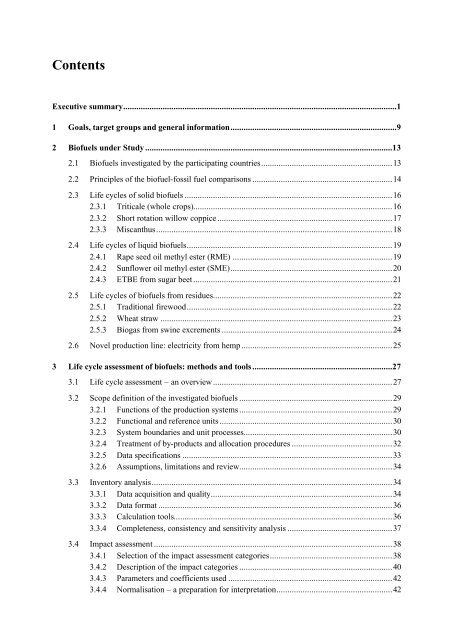BIOENERGY FOR EUROPE: WHICH ONES FIT BEST?
BIOENERGY FOR EUROPE: WHICH ONES FIT BEST?
BIOENERGY FOR EUROPE: WHICH ONES FIT BEST?
Create successful ePaper yourself
Turn your PDF publications into a flip-book with our unique Google optimized e-Paper software.
Contents<br />
Executive summary.............................................................................................................................1<br />
1 Goals, target groups and general information............................................................................9<br />
2 Biofuels under Study .................................................................................................................13<br />
2.1 Biofuels investigated by the participating countries............................................................13<br />
2.2 Principles of the biofuel-fossil fuel comparisons ................................................................14<br />
2.3 Life cycles of solid biofuels ...............................................................................................16<br />
2.3.1 Triticale (whole crops)...........................................................................................16<br />
2.3.2 Short rotation willow coppice ................................................................................17<br />
2.3.3 Miscanthus............................................................................................................18<br />
2.4 Life cycles of liquid biofuels..............................................................................................19<br />
2.4.1 Rape seed oil methyl ester (RME) .........................................................................19<br />
2.4.2 Sunflower oil methyl ester (SME)..........................................................................20<br />
2.4.3 ETBE from sugar beet ...........................................................................................21<br />
2.5 Life cycles of biofuels from residues..................................................................................22<br />
2.5.1 Traditional firewood..............................................................................................22<br />
2.5.2 Wheat straw ..........................................................................................................23<br />
2.5.3 Biogas from swine excrements ..............................................................................24<br />
2.6 Novel production line: electricity from hemp .....................................................................25<br />
3 Life cycle assessment of biofuels: methods and tools ................................................................27<br />
3.1 Life cycle assessment – an overview ..................................................................................27<br />
3.2 Scope definition of the investigated biofuels ......................................................................29<br />
3.2.1 Functions of the production systems ......................................................................29<br />
3.2.2 Functional and reference units ...............................................................................30<br />
3.2.3 System boundaries and unit processes....................................................................30<br />
3.2.4 Treatment of by-products and allocation procedures ..............................................32<br />
3.2.5 Data specifications ................................................................................................33<br />
3.2.6 Assumptions, limitations and review......................................................................34<br />
3.3 Inventory analysis..............................................................................................................34<br />
3.3.1 Data acquisition and quality...................................................................................34<br />
3.3.2 Data format ...........................................................................................................36<br />
3.3.3 Calculation tools....................................................................................................36<br />
3.3.4 Completeness, consistency and sensitivity analysis ................................................37<br />
3.4 Impact assessment .............................................................................................................38<br />
3.4.1 Selection of the impact assessment categories........................................................38<br />
3.4.2 Description of the impact categories ......................................................................40<br />
3.4.3 Parameters and coefficients used ...........................................................................42<br />
3.4.4 Normalisation – a preparation for interpretation.....................................................42

















